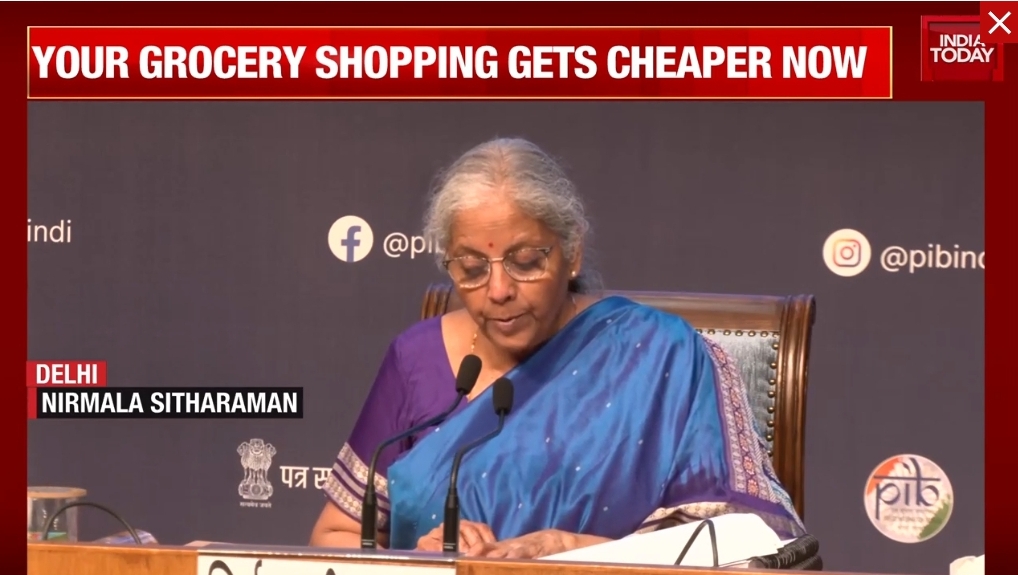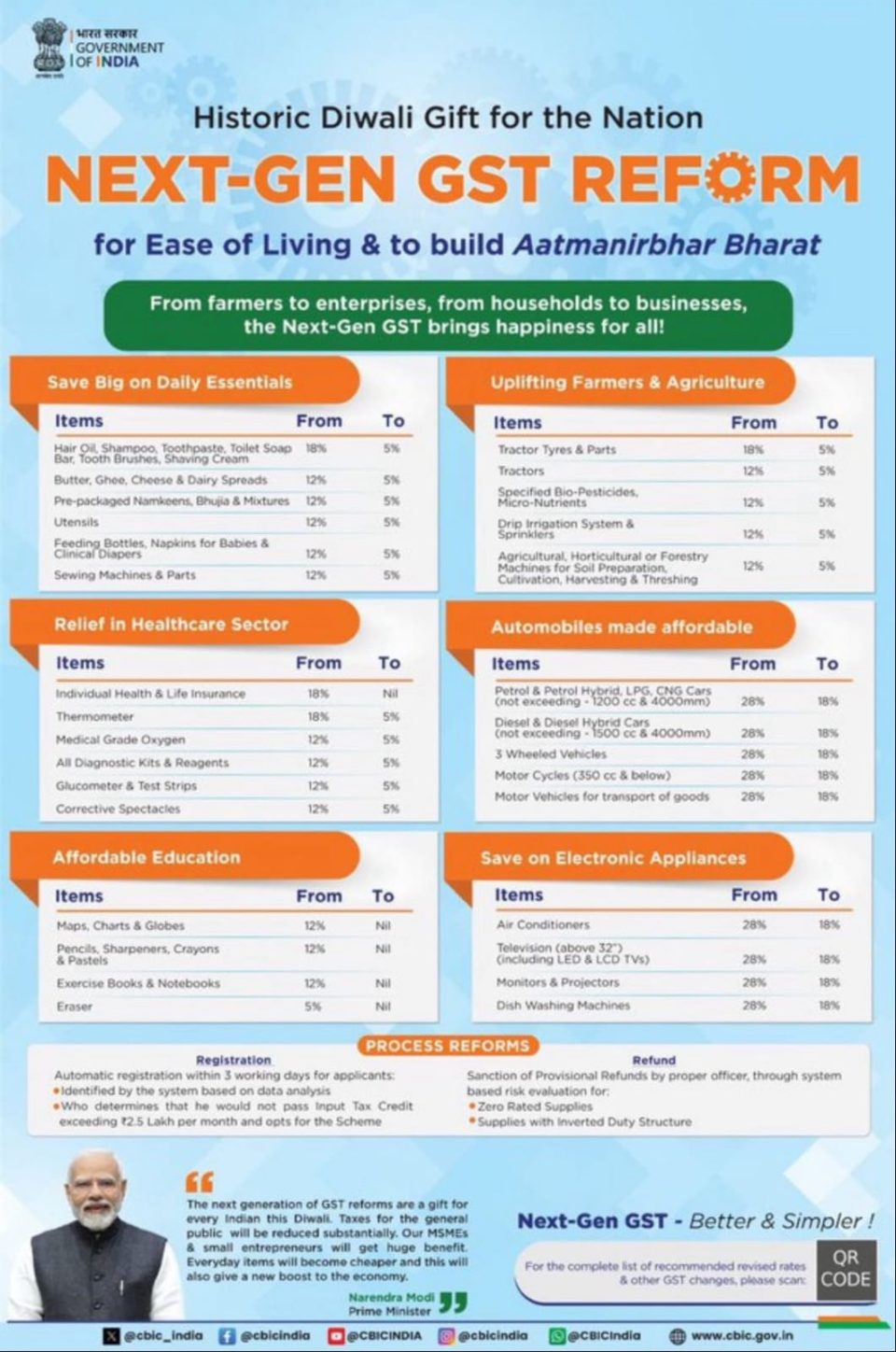India’s GST 2.0: Transforming Customer Experience Through Smart Tax Reform
India’s tax landscape is undergoing a revolutionary transformation. Moreover, this change promises to reshape how millions interact with everyday commerce. The recently announced Next-Generation GST reforms represent more than just policy adjustments. Instead, they signal a fundamental shift toward customer-centric governance that prioritizes citizen experience above bureaucratic complexity.
GST Reforms: The Customer Experience Revolution in Tax Policy
The 56th GST Council meeting delivered what Prime Minister Narendra Modi termed a “Diwali gift for the nation.” Consequently, starting September 22, 2025, India’s complex four-tier GST structure will simplify into just two primary slabs: 5% for essential goods and 18% for standard items. Additionally, a special 40% rate will apply exclusively to luxury and sin goods.
This transformation represents a profound understanding of customer psychology. Furthermore, research consistently demonstrates that simplified choices reduce cognitive load and enhance satisfaction. Therefore, by eliminating the confusing 12% and 28% slabs, the government has effectively reduced decision-making complexity for both consumers and businesses.
The GST Reforms timing proves strategically brilliant. Specifically, implementation coincides with Navratri and the festive season, when household spending typically peaks. Subsequently, this creates a psychological association between tax relief and celebration, enhancing the positive customer experience.
GST Reforms: Immediate Impact on Household Budgets
The GST reforms deliver tangible benefits across essential categories. Personal care items including shampoo, toothpaste, hair oil, and toilet soap will see dramatic reductions from 18% to 5%. Similarly, kitchen essentials like butter, ghee, cheese, and dairy spreads drop from 12% to 5%.
These changes directly address pain points in household budgeting. Previously, families struggled with unpredictable price fluctuations due to varying tax rates. Now, standardized lower rates on essentials provide predictable savings. For instance, a typical urban household spending ₹5,000 monthly on personal care could save approximately ₹650 annually through these reductions alone.
The psychological impact extends beyond mere savings. Research in behavioral economics reveals that visible price reductions create positive reinforcement loops. Consequently, consumers develop stronger brand loyalty and increased purchasing confidence when they perceive genuine value.
GST Reforms: Sectoral Transformation and Consumer Choice
The automotive sector experiences particularly dramatic changes. Small cars under 1200cc and motorcycles below 350cc transition from 28% to 18%. This shift makes aspirational products more accessible to middle-class families. Furthermore, the uniform 18% rate across auto parts eliminates previous classification confusion that often frustrated dealers and consumers alike.
Consumer electronics also benefit significantly. Air conditioners, televisions, and dishwashers move from 28% to 18%. During India’s sweltering summers, this reduction makes cooling solutions more affordable for expanding middle-class households. Additionally, the timing before the festive season positions these items as attractive purchase options.
The FMCG sector anticipates substantial demand revival. Industry leaders expect 2-3 percentage point acceleration in growth rates. Companies like Hindustan Unilever, Dabur, and Marico are preparing for increased volumes as products become more competitively priced against unbranded alternatives.
GST Reforms: Digital-First Customer Experience
Beyond rate reductions, GST 2.0 emphasizes process simplification. The government introduces pre-filled returns, automated refund processing, and risk-based assessments. These technological enhancements reduce friction in business compliance, ultimately benefiting end consumers through lower operational costs.
Small businesses particularly benefit from simplified registration procedures. The new scheme enables registration within three working days for 96% of applicants. This efficiency reduces barriers to entrepreneurship, fostering innovation that enhances customer choice and service quality.
Moreover, the quarterly filing option under QRMP allows small taxpayers to file returns quarterly instead of monthly. This reduces compliance burden while maintaining transparency. Consequently, small businesses can focus resources on customer service rather than administrative tasks.
Psychological and Behavioral Implications
The reform’s customer experience impact transcends monetary savings. Transparency in tax structure builds trust between citizens and government. Research indicates that when taxpayers understand and perceive fairness in tax systems, compliance improves dramatically.
The elimination of classification disputes particularly enhances business confidence. Previously, ambiguous category definitions created uncertainty and potential penalties. Now, clear two-rate structure minimizes interpretation errors. Therefore, businesses can price products confidently without fear of retrospective tax adjustments.
Furthermore, the reform addresses rural-urban consumption gaps. Essential items becoming cheaper benefits rural households disproportionately, as these constitute larger budget shares in lower-income families. Consequently, this narrowing of price differentials between urban and rural markets enhances overall customer experience across geographic segments.
Technology Integration and Accessibility
The reforms leverage advanced data analytics for risk assessment and fraud prevention. This technological backbone ensures legitimate businesses experience smoother operations while maintaining system integrity. Additionally, UPI and credit card payment options for GST reduce cash dependency, aligning with India’s digital payment ecosystem.
Mobile technology integration makes tax interactions more accessible. The government’s focus on app-based services reduces physical touchpoints, especially important for rural entrepreneurs lacking easy access to tax offices. Consequently, this democratizes business participation across geographic boundaries.
Industry Response and Market Dynamics
Corporate India has responded enthusiastically to these reforms. Distributors representing over 450,000 distributors and 13 million retailers welcome the changes as “landmark steps” that will strengthen supply chains. This industry confidence translates into better customer service and competitive pricing.
The cement industry particularly benefits from corrected inverted duty structures. When input costs exceed output taxes, working capital gets trapped in refunds. Consequently, by addressing these inversions, the reform frees up business capital for growth and customer service improvements.
Insurance sector transformation proves especially customer-friendly. Individual life and health insurance policies become GST-exempt, reducing premiums significantly. This makes financial protection more accessible to middle-class families, enhancing their economic security and confidence.
Economic Multiplier Effects
The reforms create positive economic cycles that enhance overall customer experience. Lower taxes on essentials increase disposable income, particularly for middle-class households. Research suggests these changes could add ₹1.98 lakh crore to consumption expenditure. Subsequently, increased spending power drives demand across sectors, creating employment and further enhancing living standards.
The festive season timing amplifies these effects. Historical data shows consumption spikes during festivals, and lower prices could extend this purchasing power. E-commerce platforms anticipate 27% growth in gross merchandise value, driven partly by these tax savings.
Rural consumption receives particular attention through agricultural equipment tax reductions. Tractors, irrigation systems, and farming implements move from 12% to 5%. This supports agricultural productivity while making technology more accessible to farmers. Consequently, rural prosperity increases, creating broader market demand.

Implementation Strategy and Change Management
The government’s phased implementation approach minimizes customer disruption. By announcing changes well before the September 22 effective date, businesses can adjust pricing and inventory management smoothly. This prevents the customer confusion that often accompanies sudden policy changes.
State governments receive revenue loss compensation guarantees, ensuring service delivery continuity. This political consensus maintains policy stability, crucial for long-term customer confidence in the tax system.
Training programs for tax officials emphasize customer service orientation rather than pure enforcement. This cultural shift toward citizen-first governance enhances the overall taxpayer experience, making interactions more collaborative than adversarial.
Long-term Vision and Sustainability
GST 2.0 aligns with India’s broader Atmanirbhar Bharat vision by making domestic products more price-competitive. When local goods become more affordable relative to imports, consumers gain access to better-quality domestic alternatives. This supports local employment while enhancing product choice and service standards.
The reform’s sustainability comes from expanding the tax base rather than increasing rates. As more businesses formalize due to simplified compliance, the system becomes self-reinforcing. Consequently, this creates a virtuous cycle where better services and lower rates coexist.
Environmental benefits emerge as sustainable products receive favorable treatment. Solar equipment and electric vehicles maintain concessional rates, encouraging environmentally conscious consumer choices. This positions India’s tax policy as a tool for positive behavioral change.
Measuring Success Through Customer Lens
The government has established citizen satisfaction metrics to track reform effectiveness. Current grievance redressal achieves 62% satisfaction rates with 15-day resolution times. These benchmarks will likely improve as tax interactions become more straightforward and predictable.
Business confidence indicators already show positive movement. Stock markets have responded favorably to the announcements, reflecting investor optimism about consumption recovery. This financial market confidence typically translates into business investment and job creation, ultimately benefiting customers through improved products and services.
The reform’s true test lies in consumption data over the coming months. Early indicators suggest positive momentum, with FMCG sales already showing recovery signs. Urban consumption grew 7.7% in Q1 FY26, outpacing rural growth for the first time in six quarters.
Conclusion: A New Era of Customer-Centric Governance
India’s GST 2.0 represents more than tax policy evolution. Instead, it exemplifies how governments can enhance customer experience through thoughtful design and implementation. By prioritizing simplicity, transparency, and affordability, these reforms create a framework where citizen satisfaction becomes a natural outcome of effective governance.
The success of this transformation will inspire similar customer-focused reforms across other government services. As India continues its journey toward becoming a developed economy, the GST 2.0 experience provides a blueprint for putting citizens first in policy design. Ultimately, this shift from complex compliance to simplified service delivery marks a fundamental evolution in how governments can enhance citizen experience through smart, technology-enabled reforms.

